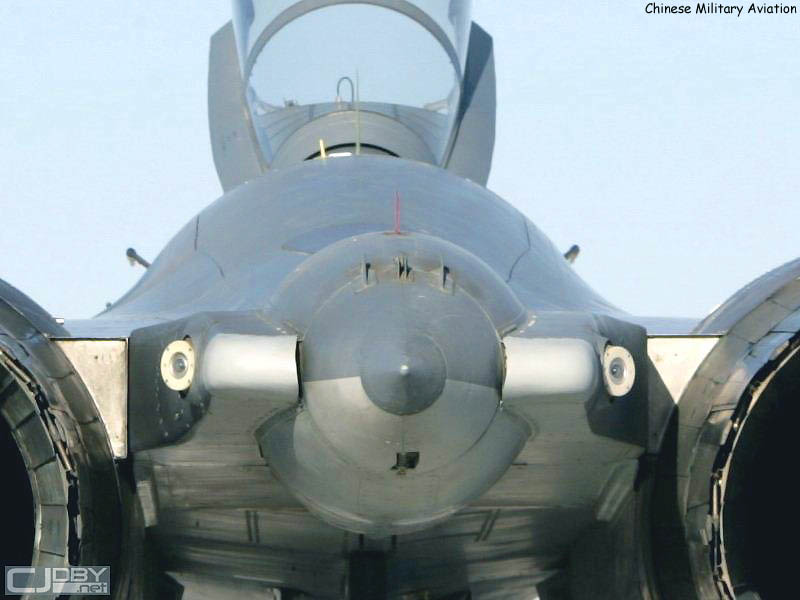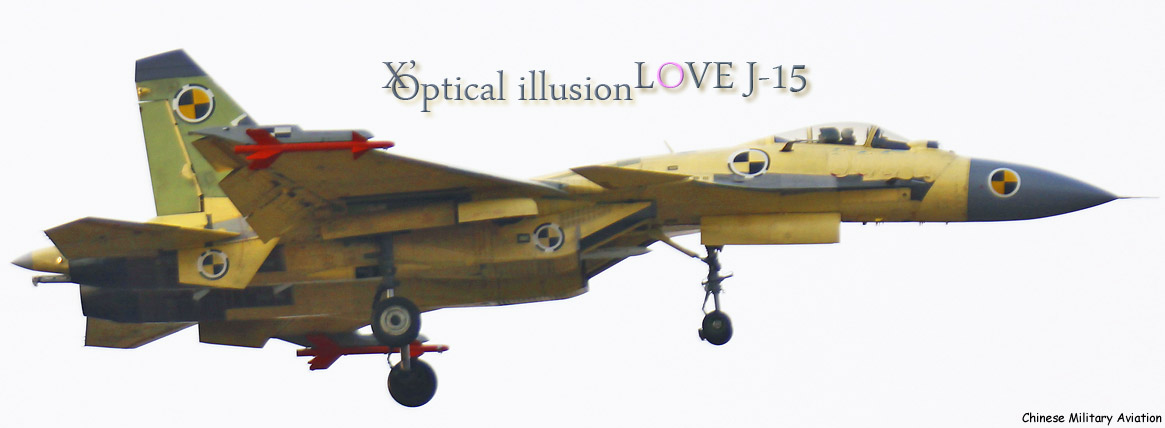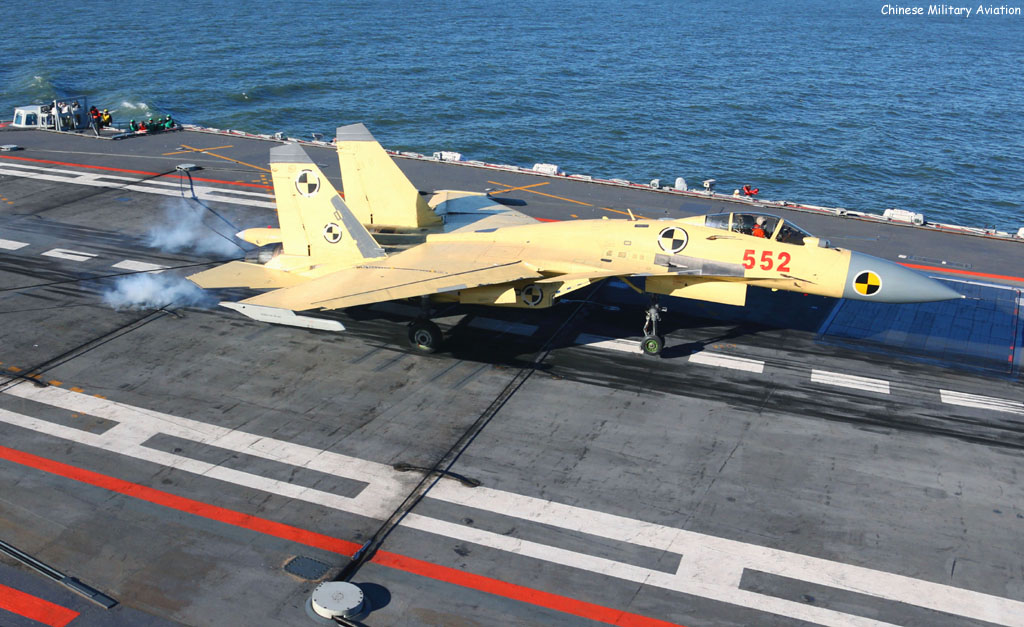






A PLAAF J-11B (K/JJ11B?) was landing carrying PL-8 and PL-12 AAMs underneath its wings. This demonstrates Chinese effort to integrate their own weapon systems into a classic Russian design in order to further boost its combat capability and survivability. Their effort includes a Chinese multifunction PD radar (Type 1493? search >150km, track 6-8, engage 4 simultaneously) and ARINC429 data bus compatible with PL-8, PL-12, and the newest PL-15 AAM, a Chinese made IRST/LR, as well as a redesigned glass cockpit featuring 5 MFDs and a new wide-angle holographic HUD. The aircraft also has a new UV band missile approach warning system (MAWS). Two sensors are installed on both sides of the tail sting to provide coverage for the rear hemisphere. There were rumors suggesting the J-11B is actually equipped with an AESA radar but this has not been confirmed. Its weight has been reduced by 700kg by using composite materials at various places. The AL-31F engine has been replaced by the indigenous WS-10A. One WS-10A (Taihang 13,200kg class) turbofan was successfully tested on a CFTE J-11WS engine testbed in June 2002. The first J-11B prototype powered by WS-10A flew in 2004. At least 3 prototypes are being tested at CFTE (#523-525), each has different configurations to test individual subsystems in order to speed up the development. The first batch of J-11B entered the service with PLAAF 1st Division (S/N 10x2x) in late 2007. However the initial batch of J-11Bs powered by the indigenous WS-10A turbofans were quickly grounded due to the poor quality of the engine. Subsequent batches were forced to be powered by Russian AL-31F turbofans until WS-10A's reliability problem was solved. Recent images (December 2009) suggested that the engine quality problem has been solved and the aircraft (02 batch?) has started to fly with WS-10As installed. Currently more J-11Bs are entering the service with PLAAF (S/N 31x0x, 40x1x, 40x3x, 60x5x, 70x0x, 72x2x), powered by WS-10A engines. In spring 2010 PLAN started to receive land-based J-11Bs (as J-11BH?), wearing a light gray camouflage (S/N 81x8x).






The J-15 (K/JJ15?) #553 prototype was taking off with full A/B from the ski ramp of aircraft carrier Liaoning on Novmeber 23, 2012. J-15 is the first generation of Chinese carrierborne fighter aircraft being developed by both 601 Institute and SAC for PLAN's first generation of aircraft carriers including Liaoning. Initially there were rumors claiming that J-15 was a new semi-stealth design based on a similar but more advanced stealth design developed earlier by SAC/601 Institute to compete for the J-20 project. In order to save time and cut cost, the aircraft turned out to be based on Russian Su-33 in terms of structural configuration and flight control system as well as domestic J-11B (see above) in terms of radar and weapon systems. Similar to Su-33, J-15 features enlarged folding wings/horizontal tailfins, strengthened landing gears with twin nose wheels, an arresting hook, a pair of small canard foreplanes and a larger wing area to improve its low speed handling and shortened tailcone to avoid tail-strike during high AoA landing. Composite materials are used in certain areas such as vertical tailfins to reduce weight. Some key shipborne aircraft technologies such as landing/navigational systems are believed to have been obtained from Russia and Ukraine. One Su-33 prototype (T-10K-3) was acquired from Ukraine around 2001 and has been studied extensively. Some components onboard J-15 are based on those onboard J-11B, such as the glass cockpit, MAWS sensors on the tail sting as well as the improved WS-10H turbofan engine with a higher TO thrust (12,800kg) and better acceleration in order to achieve full-load taking off from the ski-jump. However its fire-control radar is thought to be phased array (PESA?). It can also fire a variety of Chinese designed precision weapons, including PL-8, PL-12 AAMs, KD-88 ASM, YJ-83K AShM and YJ-91 ARM. Overall J-15 is believed to be in the same class of American F/A-18C and thus more versatile than Su-33. The aircraft is expected to be stationed onboard the aircraft carrier Liaoning just entering the service with PLAN. The first prototype was assembled at SAC in 2008. It made the maiden flight on August 31, 2009, powered by two Russian AL-31F turbofan engines. The first takeoff from a land based simulated ski-jump occurred on May 6, 2010 at CFTE. Additional J-15 prototypes (#554 & 557?) were seen wearing a light navy blue color scheme and powered by two WS-10H engines. At least 7 prototypes (S/N 551-557) have been undergoing various tests on the simulated flight decks on land, mostly powered by Russian AL-31F turbofans. It started to practice touch-and-go landings on the deck of Liaoning during her recent sea trials since summer 2012. J-15 is expected to see limited production and deployment since its technology is no longer state of the art. The next generation carrier-based stealth fighter design was rumored to be under development at 611 Institute (based on J-20?) but this has not been confirmed. A twin-seat trainer version (dubbed J-15S?) has been under development too. Its prototype first took off from SAC airfield on November 3, 2012. Similar to J-16 for PLAAF, J-15S could evolve into a dedicated naval multi-role attack aircraft in the same class of American F/A-18F and F/A-18G. It was reported that on November 23, 2012 J-15 prototypes #552 and 553 landed and took off officially for the first time on Liaoning, marking a concrete step for both J-15 and the aircraft carrier Liaoning to achieve full operational status. Currently J-15 is thought to be in small batch production.



